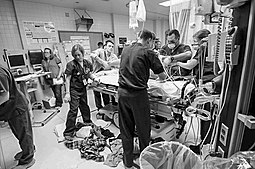
Emergency medicine

Emergency medicine, also known as accident and emergency medicine, is the medical specialty concerned with the care of illnesses or injuries requiring immediate medical attention. Emergency physicians care for unscheduled and undifferentiated patients of all ages. As first-line providers, their primary responsibility is to initiate resuscitation and stabilization and to start investigations and interventions to diagnose and treat illnesses in the acute phase. Emergency physicians generally practice in hospital emergency departments, pre-hospital settings via emergency medical services, and intensive care units, but may also work in primary care settings such as urgent care clinics. Sub-specializations of emergency medicine include disaster medicine, medical toxicology, ultrasonography, critical care medicine, hyperbaric medicine, sports medicine, palliative care, or aerospace medicine. Different models for emergency medicine exist internationally. In countries following the Anglo-American model, emergency medicine was originally the domain of surgeons, general practitioners, and other generalist physicians, but in recent decades it has become recognised as a speciality in its own right with its own training programmes and academic posts, and the specialty is now a popular choice among medical students and newly qualified medical practitioners. By contrast, in countries following the Franco-German model, the speciality does not exist and emergency medical care is instead provided directly by anesthesiologists (for critical resuscitation), surgeons, specialists in internal medicine, pediatricians, cardiologists or neurologists as appropriate. In developing countries, emergency medicine is still evolving and international emergency medicine programs offer hope of improving basic emergency care where resources are limited. Emergency Medicine is a medical specialty—a field of practice based on the knowledge and skills required for the prevention, diagnosis and management of acute and urgent aspects of illness and injury affecting patients of all age groups with a full spectrum of undifferentiated physical and behavioral disorders. It further encompasses an understanding of the development of pre-hospital and in-hospital emergency medical systems and the skills necessary for this development. The field of emergency medicine encompasses care involving the acute care of internal medical and surgical conditions. In many modern emergency departments, emergency physicians are tasked with seeing a large number of patients, treating their illnesses and arranging for disposition—either admitting them to the hospital or releasing them after treatment as necessary. They also provide episodic primary care to patients during off hours and for those who do not have primary care providers. Most patients present to emergency departments with low-acuity conditions (such as minor injuries or exacerbations of chronic disease), but a small proportion will be critically ill or injured. Therefore, the emergency physician requires a broad field of knowledge and procedural skills often including surgical procedures, trauma resuscitation, advanced cardiac life support and advanced airway management. They must have some of the core skills from many medical specialities—the ability to resuscitate a patient (intensive care medicine), manage a difficult airway (anesthesiology), suture a complex laceration (plastic surgery), set a fractured bone or dislocated joint (orthopedic surgery), treat a heart attack (cardiology), manage strokes (neurology), work-up a pregnant patient with vaginal bleeding (obstetrics and gynecology), control a patient with mania (psychiatry), stop a severe nosebleed (otolaryngology), place a chest tube (cardiothoracic surgery), and conduct and interpret x-rays and ultrasounds (radiology). This generalist approach can obviate barrier-to-care issues seen in systems without specialists in emergency medicine, where patients requiring immediate attention are instead managed from the outset by speciality doctors such as surgeons or internal physicians. However, this may lead to barriers through acute and critical care specialties disconnecting from emergency care. Emergency medicine can be distinguished from urgent care, which refers to immediate healthcare for less emergent medical issues, but there is obvious overlap and many emergency physicians work in urgent care settings. Emergency medicine also includes many aspects of acute primary care, and shares with family medicine the uniqueness of seeing all patients regardless of age, gender or organ system . The emergency physician workforce also includes many competent physicians who trained in other specialties. Physicians specializing in emergency medicine can enter fellowships to receive credentials in subspecialties such as palliative care, critical-care medicine, medical toxicology, wilderness medicine, pediatric emergency medicine, sports medicine, disaster medicine, tactical medicine, ultrasound, pain medicine, pre-hospital emergency medicine, or undersea and hyperbaric medicine. The practice of emergency medicine is often quite different in rural areas where there are far fewer other specialties and healthcare resources. In these areas, family physicians with additional skills in emergency medicine often staff emergency departments. Rural emergency physicians may be the only health care providers in the community, and require skills that include primary care and obstetrics. Patterns vary by country and region. In the United States, the employment arrangement of emergency physician practices are either private (with a co-operative group of doctors staffing an emergency department under contract), institutional (physicians with or without an independent contractor relationship with the hospital), corporate (physicians with an independent contractor relationship with a third-party staffing company that services multiple emergency departments), or governmental (for example, when working within personal service military services, public health services, veterans' benefit systems or other government agencies).
